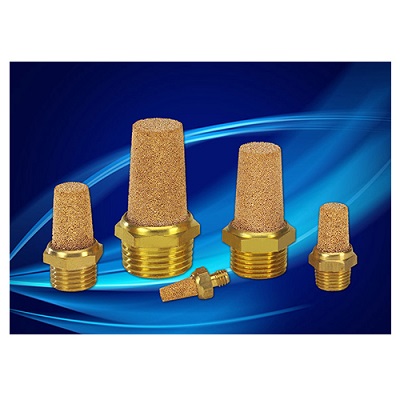Pneumatic mufflers, also called silencers, safely and quietly vent pressurized air to atmosphere. They are commonly installed on air valves, cylinders, manifolds and fittings. Without a muffler, air exhausting from many types of pneumatic-powered equipment can be so loud as to be detrimental to the surrounding environment and potentially harm workers.

Noise results when fast-moving, turbulent air exiting a port collides with the surrounding static air. Unsilenced pneumatic exhaust can be considered an air jet. In most industrial setting airflow exits at a constant velocity through an orifice and generates noise, related to the choking effect of the port and velocity. Acoustic power (noise) is a product of factors like air density and turbulence and, especially, velocity, which has an exponential effect (≈ V6) on noise generation. And above about 25 psi (2 bar), reducing pressure has minimal effect on noise abatement.
Thus, mufflers are usually needed. Typically, the devices are installed directly at the exhaust port and diffuse the released air through a porous material that increases the surface area which, in turn, reduces velocity, turbulence and noise levels. These silencers can reduce the noise from pneumatic equipment by 15 to 35 dB[A] compared to an unmuffled outlet. This is significant. Keep in mind that a 10 dB(A) reduction equates to cutting the sound level in half.
Mufflers can be constructed of plastic or metals like brass and stainless steel. They come in differing versions depending on the application. Common design styles include cone, flat-face and cylindrical shapes.
Plastic units usually have injected-molded bodies with plastic fibers or sintered plastic or metal powder inside as the noise-reducing medium. They tend to be economical, lightweight and offer high chemical resistance, and often better noise reduction than same-size metal products.
General-purpose brass products often have machined metal bodies with sintered bronze powder or compacted metal wool as the silencing material. They generally handle temperatures to about 300° F.
Stainless steel mufflers have a metal base with sintered stainless powder, wires or woven mesh. Rated working temperature reaches to around 400° F. They’re a good option for applications that require corrosion protection, durability, or operation in washdown or sterile environments. Not surprisingly, they’re more expensive than brass or plastic devices.
Sizes range from less than 0.125 in. (3 mm) to more than 2 in. (50 mm). They should meet the manufacturer’s specification for allowable pressure range and connector size and type.
But the most important consideration when installing pneumatic silencers is the effect the unit will have on airflow. Any significant restriction will reduce the working capacity of the compressed air circuit, due to back pressure brought on by undersizing or clogging with contaminants. Thus, proper selection and maintenance is essential. If an application is particularly sensitive to back pressure, opt for a unit with extra flow capacity.
As noted, the cleanliness of compressed air is an important consideration affecting back pressure and noise reduction. Thus, proper filtration is a necessity. Also, the porosity and surface area of the diffusing material vary among different products. Small pore size provides compact and effective silencers with reasonable air-flow rates. However, in air lines plagued by contamination, silencers can quickly become restricted and interfere with the working capacity of the machine to which they are fitted and, thus, may demand larger-pore materials.
Mufflers can also combine several functions in a single assembly for simplicity and space savings. For example, they can include adjustable throttle valves to control the flow rate as air exits the device. And silencers can also contain a filter to remove oil mist and dust in the exhaust air before it reaches the surroundings.
Pneumatic silencers usually connect to ports using a threaded male end. Manufacturers supply products that are compatible with most common thread standards. Some also make push-to-connect devices. Silencers should be mounted such that contaminants do not block the silencer or exhaust port. For example, horizontal or inverted mounting lets contaminants drain through the silencer using gravity and prevents clogging. (Remember that expansion in the muffler cools the air and promotes condensation.)
Finally, to avoid accidental damage, experts recommend mounting mufflers in protected areas. Plastic-bodied silencers that protrude from the machine surface are particularly prone to impact and breakage.

Leave a Reply